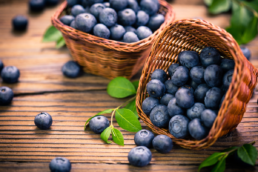Blueberries 101: Benefits, Uses, And More
This humble little berry packs quite a powerful punch. Blueberries have numerous health benefits and are a tasty treat. These berries are sweet, nutritious, and popular amongst health enthusiasts. Because of all the benefits blueberries possess, they are labeled as a superfood. Furthermore, blueberries are a low-calorie addition to your diet. Many people (myself included) consider blueberries their favorite fruit. Because it is my favorite fruit, I felt it was time to show this berry some love. This article will explore everything you need to know about blueberries, including how to eat them, health benefits, nutrients, storage, different ways to add them to your diet, and whatever else I can think of.
What Is A Blueberry?
On the off-chance you've never heard of blueberries, here is a quick science lesson. Blueberries are a native berry of North America. A berry is a fruit produced from a single flower with no barrier between the seed and the pulp. Based on this botanical definition, some "berries" are not actually berries. An example would be strawberries. It's the same brain-scratcher you deal with when you realize a tomato is a fruit and not a vegetable!
When Are Blueberries In Season?
Depending on where in North America you are located, blueberries can be harvested anytime between April and October. However, you can buy them from the grocery store year-round.
Variations of Blueberries
Generally speaking, blueberries are picked from highbush plants and lowbush plants. The berries you get from the grocery store are likely from highbush plants. Wild blueberries found in forests or fields are usually lowbush plants.
Different Ways To Store Blueberries
How w you store your blueberries will depend on how you bought/collected them as well as what you intend to do with them.
If You Bought Them Fresh:
When you buy blueberries fresh from the produce market, they are usually in a container. Put them in the fridge when you get home to keep them cool. Only wash them if you plan to immediately use them. Keeping them cool in the fridge should help them last 10-14 days.
If You Bought Them Frozen:
If you bought a frozen bag of blueberries from the store so they would last longer, get them into your freezer as quickly as possible so they do not defrost. For use in a smoothie, you can take them straight from the bag and into your blender. For use for salads, cereal, oatmeal, or to eat raw, make sure they defrost a little before consumption.
If You Bought Them Fresh But Want To Freeze Them:
For freezing blueberries yourself, place them on a baking sheet in the freezer for 1-2 hours until frozen, and then place them in an airtight container/bag. You do not need to wash them before freezing them.
What Are The Health Benefits Of Blueberries?
There are so many health benefits associated with blueberries that I could write an article on just that, so I will list of a few of the most important health benefits of blueberries for this article.
Benefit #1: Low-Calorie & Nutrient Dense
Blueberries are incredibly nutrient-dense for their size. Here are some of the nutrition stats to expect from a 1-cup serving of blueberries:
- 84 calories
- 15g carbs
- 4g Fiber
- 1g Protein
- 24% DV of Vitamin C
- 36% DV of Vitamin K
- 25% DV of Manganese
These are essential vitamins and minerals your body needs to function at 100%.
Benefit #2: Packed With Antioxidants
Antioxidants are compounds that protect your body from free radicals. These free radicals are molecules that cause cell damage and stress in the body. This damage and stress lead to inflammation and other health problems over time. Blueberries have one of the highest antioxidant levels you can find in fruits. The main antioxidant compounds blueberries possess that help protect the body are anthocyanins. Thanks to these antioxidants, your body is able to detox heavy metals, boost nitric oxide production, and much more.
Benefit #3: Lowers Blood Pressure
While plenty of other fruits and vegetables help lower blood pressure, I want to highlight blueberries. This is thanks to those antioxidants blueberries are full of. Antioxidants reduce inflammation, which makes nitric oxide production easier for the body. As nitric oxide production ramps up, your blood can flow more effectively. As a result of better blood flow, your blood pressure will lower.
Benefit #4: Improves Brain Health
Once again we have antioxidants to thank for this health benefit. Since blueberries help destroy free radicals, they also promote brain function. Free radicals slow the brain down, speed up aging, and impairs brain functions like memory and concentration. Eating more blueberries enables those antioxidants to help improve brain function and slow down mental decline.
Benefit #5: Improves Muscle Recovery
We've all been there...sore and fatigued after a grueling workout. Some of that soreness and fatigue are due to oxidative stress and inflammation from the tearing of muscle fibers. Blueberries are shown to be able to provide a little help with reducing the damage to muscles and reducing muscle soreness after a tough workout. This is another benefit we have antioxidants to thank for.
Blueberry Health Benefits: Honorable Mentions
While I will not go into detail, here is a list of some other important health benefits blueberries provide to your body:
- Helps fight UTI's
- Fights off diabetes
- Helps reduce the risk of cardiovascular disease
- Helps reduce the risk of cholesterol problems
- Reduces DNA damage
- Reduces the risk of cancer(s)*
This little berry does so many good things for us...and boy is it tasty!
Fun Ways To Add Blueberries To Your Diet
Now for the good part. There is no shortage of ways to eat blueberries, so I will provide you with a list of some popular ways to eat blueberries.
Popular ways to eat blueberries include:
- Eat them raw. Grab a handful, rinse them off, and pop them in your mouth.
- Make a smoothie. You can blend blueberries into a delicious smoothie with other fruits, vegetables, milk, yogurt, and honey for a nutritious treat!
- Add them to your oatmeal. Throw a handful or two in your bowl of oatmeal for a filling breakfast.
- Add them to your cereal. Grab a handful and pop them into your bowl of cereal.
- Mix them in your pancake batter. Who doesn't love blueberry pancakes?
- Mix them into your desserts. Yes, blueberries make a great addition to desserts. You can add them to ice cream, yogurt, frozen yogurt, cakes, pies, and cobblers.
- Use them as a salad topping. Yep, they even go with salads. You can use blueberries as a topper to various salads to provide a hint of sweetness.
- Make jam. Blueberry jam is absolutely delicious! All you need are blueberries, a little sugar, and a saucepan to cook them in.
- Make popsicles. Add some blueberries into ice cubes with a little sugar and a small stick. Freeze them for a few hours and BOOM! You have home-made blueberry popsicles.
I'm sure I'm leaving off other methods for adding blueberries into your diet, but you get the gist. They are versatile berries that have no shortage of uses.
Thinking Of Growing Your Own Blueberries?
Most of you probably do not care about growing your own blueberries, but just in case you want access to all those blueberry benefits without shopping at the store every couple of weeks this section is for you.
Here is what you need to know about growing blueberries.
1. Buy A Blueberry Plant
Find a local plant nursery to buy a blueberry plant. You can also go exploring and find a wild blueberry plant to uproot and replant as well.
2. Make Sure The Plant Can Survive.
Plant conditions need to be just right in order for it to survive. Conditions will vary based on where you live. However, what you need to know is that blueberries require clay or rocky soil to grow best. Make sure you add some compost/organic fertilizer to your soil when you plant your blueberry bush. Adding some mulch to the top of your soil will help conserve moisture if you are located somewhere with little rainfall or minimal access to water. Ideally, your blueberry bush needs 1-1.25 inches of water weekly to thrive.
Fertilize your bush in the spring and late summer. Prune your bushes during the winter to prepare for new growth the following spring. Cut off all dead branches and chop about 1 inch off the top of the berry bush when pruning in the winter.
3. Planting Multiple Berry Bushes
For multiple berry bushes, plant them 5-6 feet apart for adequate growth space. For multiple rows of bushes, give each row 8-10 feet of space so you have room to pick the berry bushes once it's time to harvest. NOTE: It can take up to 2-3 seasons before your bushes produce berries, so be patient.
Once you see blossoms in the bushes' first season, snap those blossoms off to keep the plants strong.
4. Keep Pests Away
For dealing with pest control, consider netting your bushes to keep birds at bay. Wiring cages are also an option. For specific bugs, look into natural pesticides if there are problem insects in your area. Modern pesticides contain heavy metals, so make sure you look into natural options for pesticides.
5. Harvesting Your Blueberries
Once it is finally time to pick your berries, just start picking. Usually, peak season is mid-late July up until mid-autumn once frosts start to pop up. Ripe berries will have a deep blue/indigo color. If the berry is green or has any red on it, it is not ready yet so leave it be. When picking your berries, pluck them off the bush gently to avoid breaking the branches or crushing your berries.
6. Storing Your Berries
We did cover storage for berries at the beginning of the article, but here is a quick recap: you can put them in the fridge for use within the next 10-14 days or you can freeze them for year-round use. To freeze them, put them on a baking sheet without rinsing them and let them freeze, then put them in an airtight container/bag. Make sure to rinse before eating your blueberries.
Final Thoughts
Blueberries are an incredible superfood packed with essential micronutrients and provide many health benefits for us. There are many ways to add them to your diet and they can be eaten with every meal.
If you want to learn more about specific fruits, vegetables, and general healthy living, check out the rest of our blog here.
Top 5 Veggies For A Heavy Metal Body Detox
Every day we get exposed to toxic heavy metals. This exposure comes from soil, air, water, and even food contamination. While completely avoiding heavy metal exposure is impossible, we still want to minimize exposure to the best of our ability. We want to do this because research shows us that long-term exposure to heavy metals can contribute to numerous acute and chronic health problems. Some of these diseases include cancer, heart disease, Alzheimer’s, fibromyalgia, and many others. We can help the body fight off these effects by partaking in a heavy metal body detox to eliminate these harmful toxins from the body.
There are numerous medical and natural remedies you can use to detox your body from heavy metals, and this article will look at several vegetables that help the body detox heavy metals.
Heavy Metals 101
Before we look at the vegetables I recommend for a heavy metal body detox, let’s jump into the facts about heavy metals in case this is your first deep dive into the subject matter.
How Do You Get Exposed To Heavy Metals?
The body gets exposed to heavy metals from several methods. Exposure occurs from soil contamination, water supply contamination, food supply contamination, air pollution, and industrial waste. Some lesser known methods of exposure include:
- dental fillings
- old paint
- canned foods
- vaccinations
Each method is situation-based but the fact remains that nobody can avoid some degree of heavy metal exposure.
What Are The Short-Term Effects Of Heavy Metal Exposure?
Heavy metal exposure and accumulation in the body leads to several issues that can look like other health problems. Because of this, it is recommended to get tested if you experience some of the following symptoms of acute metal toxicity.
Symptoms To Look For:
- fatigue
- headaches
- nausea
- bloating
- stomach pains
- dizziness
- difficulty remembering things
- difficulty concentrating
- high blood pressure
- hot flashes
- dry/itchy skin
- low libido
- low energy
- insomnia
Once again, these can be symptoms of numerous other health problems. Therefore, you need to be tested to either confirm or rule out heavy metal toxicity. If it is confirmed to be metal exposure, then a heavy metal body detox is the next step.
What Are The Long-Term Effects Of Heavy Metal Exposure?
Short-term effects are bad enough, but over time, the accumulation of heavy metals can contribute to plenty of other health problems. Examples of diseases that heavy metal accumulation contributes to include:
- cardiovascular disease
- cancer(s)
- Crohn’s disease
- Alzheimer’s
- liver failure
Of course, there are other factors that contribute to the development of these diseases. However, long-term heavy metal toxicity is something you can check and rule out to be safe.
How Do You Know If Heavy Metals Are To Blame For Symptoms You Are Experiencing?
The only way to know for sure is to go visit your doctor and get tested. Now, there are some hair mineral tests you can get online. However, it is still recommended to play it safe and go visit the doctor for testing. They can test hair mineral levels, saliva, and blood for metal levels. Once you know what metals you need more of or less of, you can make a plan.
Are All Metals Bad For You?
No. In fact, we need trace amounts of several metals to be healthy. Some examples of metals that are good for us in trace amounts (micronutrients) include:
- Magnesium
- Copper
- Zinc
- Calcium
- Potassium
- Sodium
- Iron
In excess, these metals are toxic to you. However, in trace amounts, they help your body perform many necessary functions to stay alive. With that said, there are other metals your body has ZERO use for. These are the toxic heavy metals you want to avoid to the best of your ability. When it comes to toxic heavy metals, there are 4 that are most toxic to you. These are:
- Mercury
- Lead
- Arsenic
- Cadmium
These are the four heavy metals most associated with poisoning and cause the most damage with minimal exposure.
What Do You Do If You Are Suffering From Heavy Metal Exposure?
If you are confirmed to have excess levels of toxic metals in your body, the next step is to eliminate them. There are a couple of ways you can do this. The easiest way is to make changes to your diet and lifestyle. The second way is to try chelation therapy. Chelation therapy is a medical procedure that involves introducing a chelating agent into the body. This chelating agent binds to metals and mobilizes them so they can be eliminated by your body’s natural detoxification pathways (urinating, bowel movements, sweating, etc).
While chelation therapy is a method that works, it can also bind to metals that your body needs, so it is best to try diet changes and lifestyle changes first and see if that helps. As long as symptoms are not dire, you can avoid medical intervention and do a heavy metal body detox at home safely.
What Diet And Lifestyle Changes Are Needed To Detox The Body?
Simply put, you want to start engaging in eating habits such as:
- Eating more leafy greens.
- Eating more fruit.
- Adding herbs and spices such as cilantro and parsley to your meals.
- Eating more flaxseeds and chia seeds.
- Drinking a cup of bone broth each day.
I will provide more detail on specific vegetables soon, but these basic diet changes will provide your body with natural chelating agents and give the body essential vitamins and minerals to keep your body’s detox system working optimally.
Some lifestyle and habit changes you can make to help the body detox heavy metals include:
- Filter your house water.
- Be wary of your fish (tuna, salmon, shellfish, and swordfish in particular).
- Ask for mercury-free vaccine alternatives.
- Opt for resin fillings over silver fillings at your next dentist visit.
- Drink more water.
- Make sure the paint in your building is lead-free.
There are other changes you can make, but these are a great place to start to minimize heavy metal exposure.
The 5 Vegetables For A Heavy Metal Body Detox
I will start off by saying there are more than 5 vegetables that will detox the body from heavy metals. However, these 5 vegetables I am listing are in my opinion the most versatile vegetables for a diet. Furthermore, these vegetables will provide other health benefits, such as boosting nitric oxide and providing essential micronutrients to keep you healthy. Now, let’s get into it.
Heavy Metal Body Detox Veggie #1: KALE
Kale is one of the most widely known healthy leafy green available. Not only does it contain numerous vitamins and minerals your body needs, but it also contains antioxidants your body uses to fight off free radicals and reduce inflammation caused by heavy metal exposure. Some of the nutrients kale contains include:
- Vitamin A
- Vitamin B6
- Vitamin C
- Vitamin K
- Potassium
- Copper
- Manganese
Heavy Metal Body Detox Veggie #2: SPINACH
The next leafy green to add to your diet for a heavy metal body detox is spinach. Spinach is packed full of essential vitamins and minerals just like kale. Also, spinach can be added to any meal of the day, making it a versatile food. Some of the nutrients you will get from spinach include:
- Vitamin A
- Vitamin C
- Vitamin K
- Folate
- Iron
- Potassium
Furthermore, you can combine kale and spinach together in a salad or smoothie for a powerful meal designed to detox the body from heavy metals on top of numerous other health benefits.
Heavy Metal Body Detox Veggie #3: MUSTARD GREENS
While this heavy metal body detox veggie is fine to eat raw, in my experience these are best eaten boiled or stewed with seasonings. These greens are packed with numerous micronutrients such as:
- Vitamin A
- Vitamin C
- Vitamin E
- Niacin
- Riboflavin
- Iron
- Calcium
- Magnesium
These greens make an excellent side dish for various types of meat, particularly beef and chicken dishes.
Heavy Metal Body Detox Veggie #4: BEETROOT
While beetroot has tons of health benefits, we are looking at what makes it good as a heavy metal body detox food. Unlike some of the other vegetables on this list, beetroot is a substantial standalone meal for those who like the taste or need a filling meat-free meal. Furthermore, beetroot contains essential micronutrients the body needs to detox heavy metals optimally. Some of these nutrients include:
- Folate
- Vitamin C
- Manganese
- Potassium
- Iron
Heavy Metal Body Detox Veggie #5: GARLIC
While I have discussed garlic before, it needs just as much love as leafy greens. This is because garlic specializes in eliminating heavy metals. Garlic contains sulfur compounds such as allicin that bind to heavy metals in the bloodstream and organs. This makes garlic a natural chelating agent. Furthermore, garlic contains other key nutrients to help the body detox heavy metals. These key nutrients include:
- Vitamin B6
- Vitamin C
- Manganese
- Fiber
- Selenium
- Potassium
Garlic is most helpful when it is chopped or diced. Also, add garlic to numerous meals as a flavor enhancer. Furthermore, garlic is useful as an ingredient in spreads and sauces.
Final Thoughts
You can add all of these veggies listed above to your daily diet in many ways. There are plenty of other vegetables you can add to your diet, and I will cover several others in a later article. Take this information and use it to conduct a safe and tasty heavy metal body detox.
To learn more about heavy metals and living a healthier life, check out the rest of our blog here.
Special Guest Dr. Tobi Jeurink
Motivating Wellness with Dr. Jay Episodes 12 and 13
We our first ever female guest this week, please welcome Dr. Tobi Jeurink! Dr. Jeurink grew up battling arthritis and autoimmune conditions , she learned at a very early age that the most effective forms of medication are the ones that not only deal with symptoms, but truly improve your overall health. Dr. Jeurink graduated from college and shortly after went on to purchase her own chiropractic clinic. She believes in combining chiropractic and gut health together. From firsthand personal experience, Dr. Jeurink is able to treat her clients to the best of her abilities, to ultimately have great success! Join Dr. Jay and Dr. Jeurink as they explore how chiropractic ties into nutrition, the root cause of health issues, and much more!
Join us each week while our founder and formulator Dr. Jay Wilkins interviews a new guest each week. Follow along on all of our social platforms.
Facebook: https://www.facebook.com/bionoxnutrients
Twitter: https://twitter.com/BioNoxNutrients
LinkedIn: Bionox
YouTube: https://www.youtube.com/playlist?list=PLaOfXNwkN4th2FBpgCKZtrvkoA0YHBFZn
Spotify @ Motivating Wellness with Dr. Jay
Special Guest Vaughn Lawrence
Motivating Wellness with Dr. Jay Episodes 8 and 9
Introducing our very first naturopath. Vaughn Lawrence is the owner of Spirit of Health in Kansas. In 2000 Lawrence relocated to Las Vegas where he earned his Doctor of Naturopathy. He then proceeded to work as a health food store manager, educator, practitioner, and consultant before returning to Kansas in 2010 to open up his own practice. Since then Lawrence has received a certification as a colon hydro therapist, nutrition response testing practitioner, dietary supplement specialist, and iridologist. Now you may be wondering what does all that mean. Well, don’t worry we got you covered, in this episode Dr. Jay and Vaughn Lawrence cover what it means to be a naturopath, the GAPS diet, and numerous heart-touching success stories. Lawrence’s ultimate goal is to make natural health educations, tools, resources, and products available to people around the world. You don’t want to miss the heart-warming stories and belief in faith told by Vaughn Lawrence, click the link below to watch!
Join us each week while our founder and formulator Dr. Jay Wilkins interviews a new guest each week. Follow along on all of our social platforms.
Facebook: https://www.facebook.com/bionoxnutrients
Twitter: https://twitter.com/BioNoxNutrients
LinkedIn: Bionox
YouTube: https://www.youtube.com/playlist?list=PLaOfXNwkN4th2FBpgCKZtrvkoA0YHBFZn
Spotify @ Motivating Wellness with Dr. Jay
Special Guest Dr. Nathan Bryan
Motivating Wellness with Dr. Jay Episodes 5-7
We are thrilled to introduce the Bionox family to, Dr. Nathan Bryan. Dr. Nathan Bryan is one of the world’s top experts in nitric oxide. He is an international leader in molecular medicine and nitric oxide biochemistry, along with the author of Functional Nitric Oxide Nutrition: Dietary Strategies to Prevent and Treat Chronic Disease (purchase now on our website)! In the next few episodes Dr. Jay and Dr. Nathan Bryan discuss opinions on nitrates, how many nitrates the average American consumers, chronic diseases, vegetation in different parts of the world, and much more. Dr. Bryan gives us details on what he thinks when he thinks about nitrates. The deep dive into the mind of a nitric oxide expert gives us a better understanding of how we can optimize our health to live life to the fullest.
Facebook: https://www.facebook.com/bionoxnutrients
Twitter: https://twitter.com/BioNoxNutrients
LinkedIn: Bionox
YouTube: https://www.youtube.com/playlist?list=PLaOfXNwkN4th2FBpgCKZtrvkoA0YHBFZn
Spotify @ Motivating Wellness with Dr. Jay





